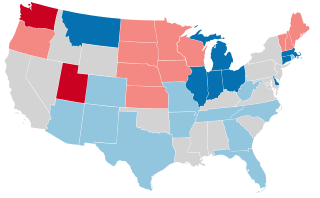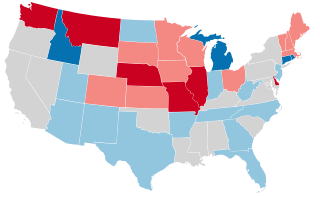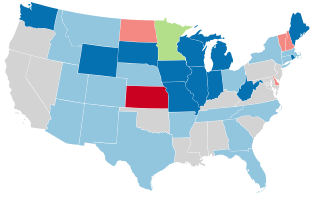
The 1996 United States Senate elections were held on November 5, 1996, with the 33 seats of Class 2 contested in regular elections. Special elections were also held to fill vacancies. They coincided with the presidential election of the same year, in which Democrat Bill Clinton was re-elected president.

The 1966 United States Senate elections were elections on November 8, 1966, for the United States Senate which occurred midway through the second term of President Lyndon B. Johnson. The 33 seats of Class 2 were contested in regular elections. Special elections were also held to fill vacancies. With divisions in the Democratic base over the Vietnam War, and with the traditional mid-term advantage of the party not holding the presidency, the Republicans took three Democratic seats, thereby breaking Democrats' 2/3rds supermajority. Despite Republican gains, the balance remained overwhelmingly in favor of the Democrats, who retained a 64–36 majority. Democrats were further reduced to 63–37, following the death of Robert F. Kennedy in June 1968.

The 1960 United States Senate elections coincided with the election of John F. Kennedy as president on November 8, 1960. The 33 seats of Class 2 were contested in regular elections. A special election was also held on June 28, 1960, for a mid-term vacancy in North Dakota where Democrats flipped a seat to expand their majority to 66–34. As Majority Leader Lyndon Johnson was elected Vice President, Mike Mansfield became the new majority leader.

The 1958 United States Senate elections were elections for the United States Senate which occurred in the middle of President Dwight D. Eisenhower's second term. Thirty-two seats of Class 1 were contested in regular elections, the new state of Alaska held its first Senate elections for its Class 2 and 3 seats, and two special elections were held to fill vacancies.

The 1952 United States Senate elections was an election for the United States Senate which coincided with the election of Dwight D. Eisenhower to the presidency by a large margin. The 32 Senate seats of Class 1 were contested in regular elections, and three special elections were held to fill vacancies. The Republicans took control of the Senate by managing to make a net gain of two seats. However, Wayne Morse (R-OR) became an independent forcing Republicans to rely on Vice President Richard Nixon's tie-breaking vote, although Republicans maintained a 48–47–1 plurality. Wayne Morse would caucus with the Republicans at the start of Congress’ second session on January 6, 1954 to allow the GOP to remain in control of the Senate. This was the third time, as well as second consecutive, in which a sitting Senate leader lost his seat.

The 1956 United States House of Representatives elections was an election for the United States House of Representatives to elect members to serve in the 85th United States Congress. They were held for the most part on November 6, 1956, while Maine held theirs on September 10. They coincided with the re-election of President Dwight D. Eisenhower.

The 1940 United States House of Representatives elections were elections for the United States House of Representatives to elect members to serve in the 77th United States Congress. They were held for the most part on November 5, 1940, while Maine held theirs on September 9. They coincided with President Franklin D. Roosevelt's re-election to an unprecedented third term. His Democratic Party narrowly gained seats from the opposition Republican Party, cementing their majority. However, the election gave firm control of the US House of Representatives and Senate to the New Dealers once again, as Progressives dominated the election.
The 1908 United States House of Representatives elections were held for the most part on November 3, 1908, with Oregon, Maine, and Vermont holding theirs early in either June or September. They coincided with the 1908 United States presidential election, which William Howard Taft won. Elections were held for all 391 seats of the United States House of Representatives, representing 46 states, to serve in the 61st United States Congress.

The 1916 United States Senate elections were elections that coincided with the re-election of President Woodrow Wilson. This was the first election since the enactment of the Seventeenth Amendment that all 32 Class 1 senators were selected by direct or popular elections instead of state legislatures. Republicans gained a net of two seats from the Democrats, and then an additional two seats through mid-term vacancies thereby reducing Democrats to a 52–44 majority.

The 1840–41 United States Senate elections were held on various dates in various states. As these U.S. Senate elections were prior to the ratification of the Seventeenth Amendment in 1913, senators were chosen by state legislatures. Senators were elected over a wide range of time throughout 1840 and 1841, and a seat may have been filled months late or remained vacant due to legislative deadlock. In these elections, terms were up for the senators in Class 2.

The 1956 Oregon gubernatorial special election took place on November 6, 1956. Democratic state senator Robert D. Holmes narrowly defeated Republican incumbent Elmo Smith to win the election.

United States gubernatorial elections were held in 1952, in 30 states, concurrent with the House, Senate elections and the presidential election, on November 4, 1952. Elections took place on September 8 in Maine. This was the last 2-year gubernatorial election Tennessee held, as they would switch from 2-year to 4-year terms in 1954.

United States gubernatorial elections were held in 1948, in 33 states, concurrent with the House, Senate elections and presidential election, on November 2, 1948. Elections took place on September 13 in Maine.

United States gubernatorial elections were held in 1940, in 34 states, concurrent with the House, Senate elections and presidential election, on November 5, 1940. Elections took place on September 9 in Maine.

United States gubernatorial elections were held in 1936, in 34 states, concurrent with the House, Senate elections and presidential election, on November 3, 1936. Elections took place on September 14 in Maine.

United States gubernatorial elections were held in 1932, in 35 states, concurrent with the House, Senate elections and presidential election, on November 8, 1932. Elections took place on September 12 in Maine.

United States gubernatorial elections were held in 1924, in 36 states, concurrent with the House, Senate elections and presidential election, on November 4, 1924. Elections took place on October 7, 1924 in Arkansas, and September 8, 1924 in Maine.

United States gubernatorial elections were held in 1912, in 33 states, concurrent with the House, Senate elections and presidential election, on November 5, 1912. In addition, there was a special election in Georgia on January 10, 1912.

United States gubernatorial elections were held in 1906, in 28 states, concurrent with the House and Senate elections, on November 6, 1906.

The 1960 United States Senate elections in Oregon took place on November 8, 1960.



















